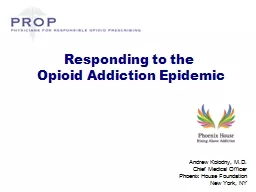

Andrew Kolodny MD Chief Medical Officer Phoenix House Foundation New York NY The Opium Poppy Papaver Somniferum 2 Crude Opium Latex on Poppy Head 3 Opioids Morphine Codeine Thebaine ID: 934073
Download Presentation The PPT/PDF document "Responding to the Opioid Addiction Epid..." is the property of its rightful owner. Permission is granted to download and print the materials on this web site for personal, non-commercial use only, and to display it on your personal computer provided you do not modify the materials and that you retain all copyright notices contained in the materials. By downloading content from our website, you accept the terms of this agreement.
Slide1
Responding to the Opioid Addiction Epidemic
Andrew Kolodny, M.D.Chief Medical OfficerPhoenix House FoundationNew York, NY
Slide2The Opium PoppyPapaver Somniferum2
Slide3Crude Opium Latex on Poppy Head3
Slide4OpioidsMorphine CodeineThebaineDiacetylmorphine (Heroin)
Hydrocodone (Vicodin)Oxycodone (Oxycontin)Oxymorphone (Opana)
Hydromorphone (
Dilaudid
)
Naturally occurring opioids- also called opiates
Semi-synthetic opioids
Slide5Prior Opioid Addiction EpidemicsLate 1800s: MorphineMainly middle classFemale > Male Early 1900s: Heroin (pharmaceutical grade)First generation Italians, Jews, Irish
Male > Female1950s-1970s- Heroin (illicit)African American/Latinos Male > Female
Slide66Governor Shumlin devotes entire state of the state speech to Vermont’s opioid addiction epidemic
Slide7HeroinCocaine
38,329 drug overdose deaths in 2010
Unintentional Drug Overdose Deaths
United States, 1970–2007
National Vital Statistics System, http://wonder.cdc.gov
Year
Slide8Drug Overdose Deaths by Major Drug Type,United States, 1999–2010
CDC, National Center for Health Statistics, National Vital Statistics System, CDC Wonder. Updated with 2010 mortality data.
Slide9Primary non-heroin opiates/synthetics admission rates, by State (per 100,000 population aged 12 and over)
9
Slide10Primary non-heroin opiates/synthetics admission rates, by State (per 100,000 population aged 12 and over)
10
Slide11Primary non-heroin opiates/synthetics admission rates, by State (per 100,000 population aged 12 and over)
11
Slide12Primary non-heroin opiates/synthetics admission rates, by State (per 100,000 population aged 12 and over)
12
Slide13Primary non-heroin opiates/synthetics admission rates, by State (per 100,000 population aged 12 and over)
13
Slide14Primary non-heroin opiates/synthetics admission rates, by State (per 100,000 population aged 12 and over)
14
Slide1515Non-heroin opioid admissions, by gender, age, race/ethnicity: 2011
Slide1616
Heroin admissions, by age group & race/ethnicity: 2001- 2011
Slide17Unintentional overdose deaths involving opioid analgesics parallel per capita sales of opioid analgesics in morphine equivalents by year, U.S., 1997-2007Source: National Vital Statistics System, multiple cause of death dataset, and DEA ARCOS* 2007 opioid sales figure is preliminary.Number of Deaths
Opioid sales (mg/person)*
Slide18Rates of Opioid Sales, OD Deaths, and Treatment, 1999–2010
CDC.
MMWR
2011
Slide1919
Slide2020
Slide21Source: United States General Accounting Office: Dec. 2003, “OxyContin Abuse and Diversion and Efforts to Address the Problem.”
Dollars Spent Marketing OxyContin (1996-2001)
Slide22Industry-funded “education” emphasizes:Opioid addiction is rare in pain patients.Physicians are needlessly allowing patients to suffer because of “opiophobia.”Opioids are safe and effective for chronic pain.Opioid therapy can be easily discontinued.
22
Slide23Industry-funded organizations campaigned for greater use of opioids Pain Patient GroupsProfessional Societies The Joint CommissionThe Federation of State Medical Boards23
Slide24Porter J, Jick H. Addiction rare in patients treated with narcotics. N Engl J Med. 1980 Jan 10;302(2):123
Cited 824 times (Google Scholar)“The risk of addiction is much less than 1%”
24
Slide25N Engl J Med. 1980 Jan 10;302(2):123.25
Slide26Slide27“
I think that after 20 years of a failed experiment that there are not many people supporting this except for the die-hards and the pharmaceutical industry.” Jane C. Ballantyne, MD FRCAProfessor, Univ. of Washington
Source:
New York Times, April 9, 2012.
“
Tightening the Lid on Pain Prescriptions
”
.
Slide28Urine Tox Results in Chronic Pain Patients on Opioid TherapySource: Couto JE, Goldfarb NI, Leider HL, Romney MC, Sharma S. High rates of inappropriate drug use in the chronic pain population. Popul Health Manag. 2009;12(4):185–190.28
Slide29Controlling the epidemic:A Three-pronged ApproachPrevent new cases of opioid addiction.Treatment for people who are already addictedSupply control- Medical board & law enforcement efforts to reduce over-prescribing and black-market availability.
29
Slide30Opioid manufacturers continue to advertise opioids as
safe and effective for chronic pain.
Slide31How the opioid industry Frames the ProblemSource: Slide presented by Lynn R. Webster MD at FDA meeting on hydrocodone upscheduling, January 25th, 2013.
Slide32Drug overdose death rates by intent by age group, US, 2008
Slide33Pain Patients
“
Drug Abusers
”
63% admitted to using opioids for purposes other than pain
1
35% met DSM V criteria for addiction
2
1. Fleming MF, Balousek SL, Klessig CL, Mundt MP, Brown DD. Substance Use Disorders in a Primary Care Sample Receiving Daily Opioid Therapy. J Pain 2007;8:573-582.
2. Boscarino JA, Rukstalis MR, Hoffman SN, et al. Prevalence of prescription opioid-use disorder among chronic pain patients: comparison of the DSM-5 vs. DSM-4 diagnostic criteria. J Addict Dis. 2011;30:185-194.
This is a
false dichotomy
Aberrant drug use behaviors are common in pain patients
92% of opioid OD decedents were prescribed opioids for chronic pain.
3. Johnson EM, Lanier WA, Merrill RM, et al. Unintentional Prescription Opioid-Related Overdose Deaths: Description of Decedents by Next of Kin or Best Contact, Utah, 2008-2009. J Gen Intern Med. 2012 Oct 16.
Slide34Frequently Discussed InterventionsAbuse-deterrent formulationsExpanding access to naloxoneExpanding access to medication assisted treatmentPrescription Drug Monitoring Practices-based interventionsMandatory prescriber education34
Slide35Slide36Buprenorphine TreatmentPartial agonistWeaker effectsSafer to useLong duration of actionMilder withdrawal symptoms
Slide37Full Opioid Agonists
Slide38Buprenorphine- A Partial Agonist
Slide39SummaryWe are in the midst of the worst drug epidemic in U.S. history.To end the epidemic we need to:PREVENT new cases of opioid addictionTREAT people who are already addicted39
Slide40www.supportPROP.orgPlease visit
40
@
andrewkolodny